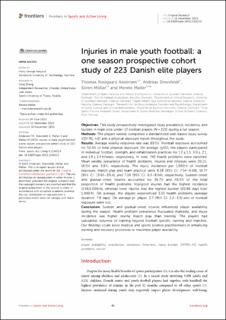| dc.contributor.author | Andersen, Thomas Rostgaard | |
| dc.contributor.author | Drevsfeldt, Andreas | |
| dc.contributor.author | Möller, Sören | |
| dc.contributor.author | Møller, Merete | |
| dc.date.accessioned | 2024-03-15T15:31:37Z | |
| dc.date.available | 2024-03-15T15:31:37Z | |
| dc.date.created | 2024-01-11T14:26:14Z | |
| dc.date.issued | 2023 | |
| dc.identifier.citation | Frontiers in Sports and Active Living. 2023, 5, Artikkel 1250223. | en_US |
| dc.identifier.issn | 2624-9367 | |
| dc.identifier.uri | https://hdl.handle.net/11250/3122734 | |
| dc.description | This is an open-access article distributed under the terms of the Creative Commons Attribution License (CC BY). The use, distribution or reproduction in other forums is permitted, provided the original author(s) and the copyright owner(s) are credited and that the original publication in this journal is cited, in accordance with accepted academic practice. No use, distribution or reproduction is permitted which does not comply with these terms. | en_US |
| dc.description.abstract | Objectives: This study prospectively investigated injury prevalence, incidence, and burden in male elite under-17 football players (N = 223) during a full season.
Methods: The players weekly completed a standardized web-based injury survey (OSTRC-H2) and a physical exposure report throughout the study.
Results: Average weekly response rate was 89.5%. Football exposure accounted for 52.4% of total physical exposure. On average (±SD), the players participated in individual football, strength, and rehabilitation practices for 1.2 ± 1.5, 3.0 ± .2.1, and 1.9 ± 3.4 h/week, respectively. In total, 742 health problems were reported. Mean weekly prevalence of health problems, injuries and illnesses were 20.1%, 16.5% and 3.8%, respectively. The injury incidence per 1,000 h of football exposure, match play and team practice were 8.28 (95% CI: 7.54–9.08), 16.77 (95% CI: 13.65–20.4), and 7.24 (95% CI: 6.5–8.04), respectively. Sudden-onset and gradual-onset injuries accounted for 36.7% and 43.4% of the total proportion of health problems. Hip/groin injuries had the highest incidence (1.58/1,000 h), whereas knee injuries had the highest burden (20.86 days lost/1,000 h). On average, the players experienced 3.33 health problems (average duration: 7.8 days). On average pr. player, 2.7 (95% CI: 2.2–3.3) wks of football exposure were lost.
Conclusion: Sudden and gradual-onset injuries influenced player availability during the season. Health problem prevalence fluctuated markedly, and injury incidence was higher during match play than training. The players had substantial volumes of training beyond football-specific training and matches. Our findings could assist medical and sports science practitioneers in enhancing training and recovery processes to maximize player availability. | en_US |
| dc.language.iso | eng | en_US |
| dc.subject | health problems | en_US |
| dc.subject | incidence | en_US |
| dc.subject | injury burden | en_US |
| dc.subject | OSTRC-H2 | en_US |
| dc.subject | player availability | en_US |
| dc.subject | prevalence | en_US |
| dc.subject | soccer | en_US |
| dc.subject | time-loss | en_US |
| dc.title | Injuries in male youth football: A one season prospective cohort study of 223 Danish elite players | en_US |
| dc.type | Peer reviewed | en_US |
| dc.type | Journal article | en_US |
| dc.description.version | publishedVersion | en_US |
| dc.rights.holder | © 2023 Andersen, Drevsfeldt, Möller and Møller | en_US |
| dc.source.pagenumber | 13 | en_US |
| dc.source.volume | 5 | en_US |
| dc.source.journal | Frontiers in Sports and Active Living | en_US |
| dc.identifier.doi | 10.3389/fspor.2023.1250223 | |
| dc.identifier.cristin | 2224704 | |
| dc.description.localcode | Institutt for idrettsmedisinske fag / Department of Sports Medicine | en_US |
| dc.source.articlenumber | 1250223 | en_US |
| cristin.ispublished | true | |
| cristin.fulltext | original | |
| cristin.qualitycode | 1 | |
